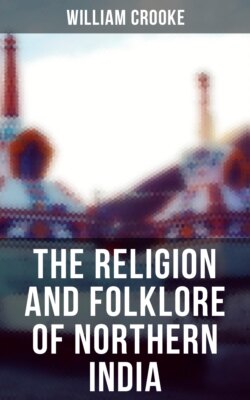Читать книгу The Religion and Folklore of Northern India - William Crooke - Страница 74
На сайте Литреса книга снята с продажи.
Worship of Gansâm Deo.
ОглавлениеTable of Contents
We now come to consider some divinities special to the Drâvidian races, who touch on the North-Western Provinces to the south, across the Kaimûr and Vindhyan ranges, the physical as well as the ethnical frontier between the valleys of the Ganges and Jumnâ and the mountain country of Central India. The chief Gond deity is Gansâm Deo. Some vague attempt has been made to elevate him into the pantheon of Brâhmanism, and his name has been corrupted into Ghanasyâma, which means in Sanskrit, “black like the heavy rain clouds of the rainy season,” and is an epithet of Râma and of Krishna. One legend derives him from an actual Gond chieftain, just as many of the local godlings whom we shall consider afterwards have sprung from real living persons of eminence, or those who have lost their lives in some exceptional way. It is said that this chieftain was devoured by a tiger soon after his marriage. As might have been expected, his spirit was restless, and one year after his death he visited his wife and she conceived by him. Instances of such miraculous conceptions are common in folk-lore.69 “The descendants of this ghostly embrace are, it is said, living to this day at Amoda, in the Central Provinces. He, about the same time, appeared to many of his old friends, and persuaded them that he could save them from the maws of tigers and other calamities, if his worship were duly inaugurated and regularly performed; and in consequence of this, two festivals in the year were established in his honour; but he may be worshipped at any time, and in all sickness and misfortunes his votaries confidently appeal to him.”70
In the Hill country of Mirzapur, the shrine of Gansâm is about one hundred yards from the village site and without any ornamentation. Both inside and outside is a platform of mud, on which the deity can rest when so disposed. The only special offerings to him are the curious water-pots (kalsa) already described, and some rude clay figures of horses and elephants, which are regarded as the equipage (sawârî) of the deity. In the Central Provinces, “a bamboo with a red or yellow flag tied to the end is planted in one corner, an old withered garland or two is hung up, a few blocks of rough stone, some smeared with vermilion, are strewn about the place which is specially dedicated to Gansâm Deo.”71
